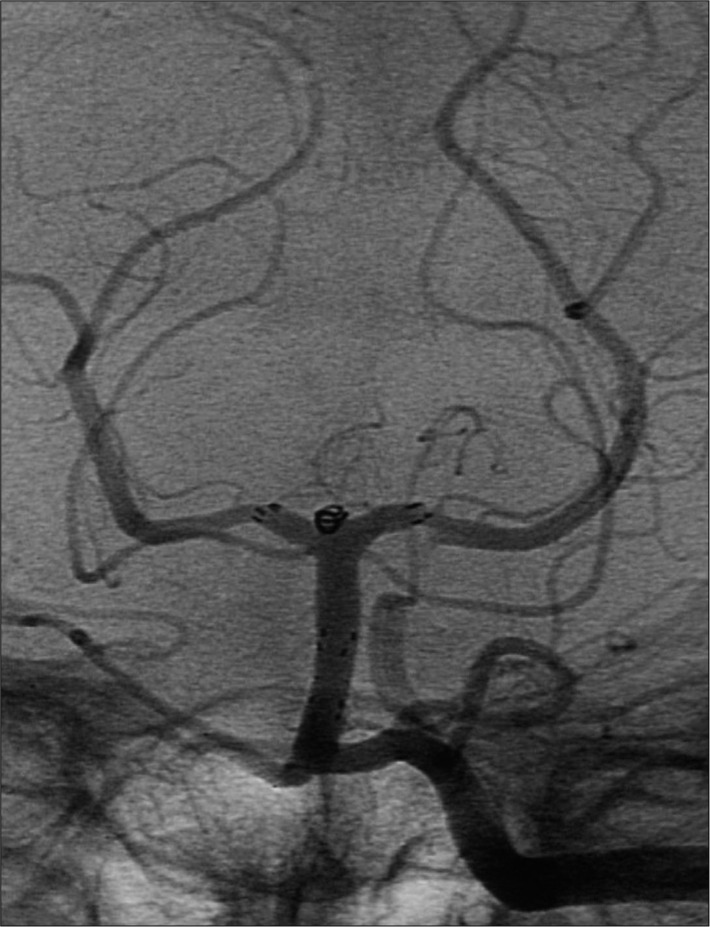J Korean Neurosurg Soc.
2012 Sep;52(3):187-192.
Y-Stenting Endovascular Treatment for Ruptured Intracranial Aneurysms : A Single-Institution Experience in Korea
- Affiliations
-
- 1Department of Neurosurgery, Dankook University College of Medicine, Cheonan, Korea. babyface@dankook.ac.kr
Abstract
OBJECTIVE
Stent-assisted coiling on intracranial aneurysm has been considered as an effective technique and has made the complex aneurysms amenable to coiling. To achieve reconstruction of intracranial vessels with preservation of parent artery the use of stents has the greatest potential for assisted coiling. We report the results of our experiences in ruptured wide-necked intracranial aneurysms using Y-stent coiling.
METHODS
From October 2003 to October 2011, 12 patients (3 men, 9 women; mean age, 62.6) harboring 12 complex ruptured aneurysms (3 middle cerebral artery, 9 basilar tip) were treated by Y-stent coiling by using self-expandable intracranial stents. Procedural complications, clinical outcome, and initial and midterm angiographic results were evaluated. The definition of broad-necked aneurysm is neck diameter over than 4 mm or an aneurysm with a neck diameter smaller than 4 mm in which the dome/neck ratio was less than 2.
RESULTS
In all patients, the aneurysm was successfully occluded with no apparent procedure-related complication. There was no evidence of thromboembolic complication, arterial dissection and spasm during procedure. Follow-up studies showed stable and complete occlusion of the aneurysm in all patients with no neurologic deficits.
CONCLUSION
The present study did show that the Y-stent coiling seemed to facilitate endovascular treatment of ruptured wide-necked intracranial aneurysms. More clinical data with longer follow-up are needed to establish the role of Y-stent coiling in ruptured aneurysms.
Keyword
MeSH Terms
Figure
Reference
-
1. Benitez RP, Silva MT, Klem J, Veznedaroglu E, Rosenwasser RH. Endovascular occlusion of wide-necked aneurysms with a new intracranial microstent (Neuroform) and detachable coils. Neurosurgery. 2004; 54:1359–1367. discussion 1368. PMID: 15157292.
Article2. Cekirge HS, Yavuz K, Geyik S, Saatci I. A novel "Y" stent flow diversion technique for the endovascular treatment of bifurcation aneurysms without endosaccular coiling. AJNR Am J Neuroradiol. 2011; 32:1262–1268. PMID: 21527573.
Article3. Chow MM, Woo HH, Masaryk TJ, Rasmussen PA. A novel endovascular treatment of a wide-necked basilar apex aneurysm by using a Y-configuration, double-stent technique. AJNR Am J Neuroradiol. 2004; 25:509–512. PMID: 15037483.4. Fiorella D, Albuquerque FC, Han P, McDougall CG. Preliminary experience using the Neuroform stent for the treatment of cerebral aneurysms. Neurosurgery. 2004; 54:6–16. discussion 16-17. PMID: 14683536.
Article5. Higashida RT, Smith W, Gress D, Urwin R, Dowd CF, Balousek PA, et al. Intravascular stent and endovascular coil placement for a ruptured fusiform aneurysm of the basilar artery. Case report and review of the literature. J Neurosurg. 1997; 87:944–949. PMID: 9384409.
Article6. Hsu SW, Chaloupka JC, Feekes JA, Cassell MD, Cheng YF. In vitro studies of the neuroform microstent using transparent human intracranial arteries. AJNR Am J Neuroradiol. 2006; 27:1135–1139. PMID: 16687559.7. Katsaridis V, Papagiannaki C, Violaris C. Embolization of acutely ruptured and unruptured wide-necked cerebral aneurysms using the neuroform2 stent without pretreatment with antiplatelets : a single center experience. AJNR Am J Neuroradiol. 2006; 27:1123–1128. PMID: 16687556.8. Kwon OK, Kim SH, Oh CW, Han MH, Kang HS, Kwon BJ, et al. Embolization of wide-necked aneurysms with using three or more microcatheters. Acta Neurochir (Wien). 2006; 148:1139–1145. discussion 1145. PMID: 16990989.
Article9. Moret J, Cognard C, Weill A, Castaings L, Rey A. [Reconstruction technic in the treatment of wide-neck intracranial aneurysms. Long-term angiographic and clinical results. Apropos of 56 cases]. J Neuroradiol. 1997; 24:30–44. PMID: 9303942.10. Perez-Arjona E, Fessler RD. Basilar artery to bilateral posterior cerebral artery 'Y stenting' for endovascular reconstruction of wide-necked basilar apex aneurysms : report of three cases. Neurol Res. 2004; 26:276–281. PMID: 15142320.
Article11. Ries T, Grzyska U, Fiehler J. Antiaggregation before, during, and after coiling of unruptured aneurysms : growing evidence between scylla and charybdis. AJNR Am J Neuroradiol. 2008; 29:e33. PMID: 18258707.12. Sani S, Lopes DK. Treatment of a middle cerebral artery bifurcation aneurysm using a double neuroform stent "Y" configuration and coil embolization : technical case report. Neurosurgery. 2005; 57:E209. discussion E209. PMID: 15987593.13. Sedat J, Chau Y, Mondot L, Vargas J, Szapiro J, Lonjon M. Endovascular occlusion of intracranial wide-necked aneurysms with stenting (Neuroform) and coiling mid-term and long-term results. Neuroradiology. 2009; 51:401–409. PMID: 19241069.
Article14. Vallée JN, Pierot L, Bonafé A, Turjman F, Flandroy P, Berge J, et al. Endovascular treatment of intracranial wide-necked aneurysms using three-dimensional coils : predictors of immediate anatomic and clinical results. AJNR Am J Neuroradiol. 2004; 25:298–306. PMID: 14970036.
- Full Text Links
- Actions
-
Cited
- CITED
-
- Close
- Share
- Similar articles
-
- Current Update on the Randomized Controlled Trials of Intracranial Aneurysms
- Comprehension of Two Modalities: Endovascular Coiling and Microsurgical Clipping in Treatment of Intracranial Aneurysms
- Safety and effectiveness of Neuroform Atlas stent-assisted coil embolization for ruptured intracranial aneurysms
- Endovascular treatment of intracranial aneurysms: Past and present
- Two consecutive ruptured intracranial aneurysm in patient with multiple intracranial aneurysms







